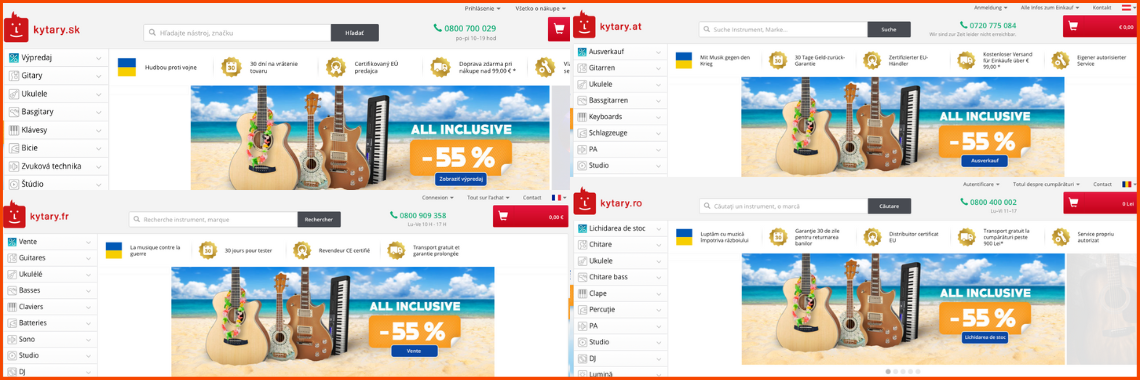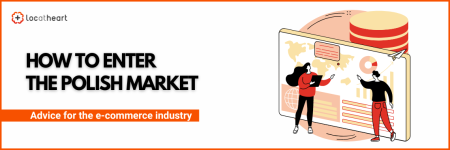Expansion at the Tower of Babel, or why content translation is the key to growing your business
Do you run an online store? Is your business all about creating content for your customers? Or maybe your sales figures aren’t satisfying enough? (They always could be better, the sky’s the limit!) Maybe it is high time you crossed the border, expanded your business and attracted new customers. There are surely a lot of people in the neighbouring countries and even around the world who would be interested in whatever it is that you offer – the only problem is that they have no idea you exist. Thankfully, the borders that separate different sovereign states are not precipitous pits at the bottom of which flow rivers of hot lava in the form of a foreign language. With the help of experts, language can become a bridge and an ally in your fight for the customer, while also giving you a huge opportunity for business expansion.
Lingua franca – the key to international markets
As a result of a chain of historical events and global political changes, today it is English that enjoys the status of a universal language which dominates education, trade and employment.
Research shows that “English is the first foreign language in 100% of secondary curricula, including in countries which have been opposed to US hegemony, such as Iran” (King 2018).
That is why it is no surprise that more than 60% of websites on the world wide web use this language (W3Techs 2022).
Some of these sites are part of the ever-thriving e-commerce industry. Translating your content (including an e-shop, product catalogue, marketing materials, etc.) into English automatically makes whatever you sell accessible to a huge group of foreign customers. How huge are we talking about, though?
Let’s go (online) shopping
The number of internet users who do their shopping online is steadily increasing. In the European Union alone, they accounted for 63% of all netizens in 2016, and by 2021, this figure had already risen to 74% (Eurostat 2022).
In the past, the exponential growth of e-commerce was brought on by technological advances and the digital revolution, but more recently, it has been the pandemic that has forced people to look for safer ways of purchasing goods and for an alternative to brick-and-mortar stores.
Consumers, however, are no longer shopping only at domestic e-stores. They compare various offers and choose the best one available, even if it means ordering goods from abroad.

Once again, the numbers speak for themselves – in 2021, more than 30% of European customers bought products from sellers operating in a different country than their own, and over 20% – from e-tailers outside of the European Union. And those percentages will only keep rising.
E-commerce is one of the many industries affected by the pandemic and the ongoing war in Ukraine. Despite the difficult circumstances, online trade continues to evolve and take on new challenges.

Currently, main future goals concern shortening supply chains (which opens up another opportunity for country-specific entrepreneurs) and improving the overall logistics.
One of the innovations in this area is Amazon Merch – a print-on-demand service created to facilitate selling T-shirts with unique designs through Amazon. The American giant will take it upon itself to print the graphics onto the clothes and deliver the products to the customers, which means that sellers will not have to worry about manufacturing costs and storage space.
What to translate? Everything!
Still, English is not only a mean of communication with customers who live abroad. It is also a way to reach those foreigners who live in your country and know English, but at the same time don’t speak your native tongue fluently enough to be able to shop comfortably.
Nevertheless, translation does not have to (and should not) concern only product catalogues or descriptions.
Any type of content you want to share with the world could gain a huge group of new recipients – and offer an opportunity for monetisation – by being translated into the lingua franca. It really could be anything – an e-commerce guide, a video for investors, a course on how to use a computer program… Nonna’s famous dumplings recipe or even a review of a popular brand’s newest generation TV set.
After all, people’s needs are basically the same, regardless of where the person scouring the web for a solution to an urgent problem comes from or currently lives.
Whatever you offer, with translation – which, without a question, should be outsourced to experts – you make yourself and your brand stand out internationally. And this is a really important step towards business expansion. A very important step, if we might say so, though not the only one.
National languages – the key to the customer’s heart (and wallet)
Some people say that everything starts with the customer. When it comes to e-commerce, you might add, “and with their native language” – having your website available only in one language version might just not cut it.
While it is true that English is still at the very core of cross-cultural communication and cross-border commerce, at the end of the day, customers prefer to engage with content in their own language anyway – that is what 90% of internet users in the European Union think (European Commission 2011).
A 2019 PayU study (per Żbikowska & Wąsowska 2021) only confirms this huge percentage – research shows that the lack of a language version in the user’s native tongue discourages people from shopping in foreign e-shops (it is no. 8 on the list of potential drawbacks associated with services of this type).

Unlike the language purist (who, let’s be real, is also often a snob), who grinds their teeth and sees red at the mere thought that the original version of their beloved work could be ruined by a translation, the average consumer goes online shopping and expects a given website, e-shop or marketplace to meet their requirements – one of which is content in their mother tongue.
But everyone already speaks English…
The phrase, “But everyone already speaks English!”, repeated like a mantra, is actually very far from the truth. And it is not just because the language is spoken by only a quarter of internet users around the world.
Even in the countries where proficiency in English as a second language is at a very high level, people prefer using their native tongue – the prime example is Sweden. Statistics indicate that 80% of Swedes who shop online would rather do it in their own language (Graham 2011).
When consumers come across content in their mother tongue, they feel more confident about making a purchase, as they are not worried about misunderstanding something and making a mistake.
Even when it comes to English itself, one should assume that the consumer expects the vocabulary and spelling to be adapted to the language version they use on a daily basis. For instance, a customer from London and a resident of New York will both have different expectations of the content, although there are many more varieties of English than just British and American.

Buy, like, subscribe and come back for more
If there is a large percentage of immigrants in a given country, they, too, would like to be able to take advantage of different services or make purchases in their own language – including brick-and-mortar shops.
For example, Polish entrepreneurs are successfully translating content into Ukrainian, and the United States has been offering content in the native tongues of Latin Americans or Asians for years.
Also, keep in mind that before a customer steps into your establishment, service point or restaurant, they will most likely look up your business or the products you offer on the internet.
According to the Forbes magazine, 82% of smartphone users were checking product information before buying goods in brick-and-mortar shops – and that was already in 2018 (Ellett 2018).
Every tower needs a strong foundation
Nevertheless, those observations do not mean that English is becoming unnecessary. On the contrary, English translations, which already are incredibly functional, can and should become the basis for translations into other languages.
By using English as a pivot language, we can avoid the (often extremely costly) need to outsource translations to specialists who fluently speak certain language pairs, including rare ones such as Greek–Georgian or Polish–Romanian.
In most cases, all you need to do is find someone who can translate the text from the English master version which will save you a considerable amount of money.
Regardless of whether you translate Hungarian content into English or English content into any of the other European or Asian languages, you should always outsource the task to a professional translation agency.
It will help you avoid linguistic, stylistic, grammatical and punctuation mistakes that could possibly make your brand, products and services less trustworthy, discourage consumers from making a purchase and – worst-case scenario – make them look for an alternative source of fulfilment of a given need. Just think about it – would you enter your credit card details on a website full of typos?
Well, neither would we. (You can read more about how mistranslations and linguistic errors can impact business here.)
Conquer foreign markets and expand your business. It will open a whole bunch of new doors for you, allowing you to become a global player and attract new customers who previously seemed out of your reach. The most important thing is to offer them the right language version and high-quality content localisation so that they will confidently choose whatever it is that your offer (and pay in hard money!). We would love to help you achieve your goals – don’t hesitate to reach out to us.
Stay informed
Sources
Ellett, J. (2018, February 8). New Research Shows Growing Impact of Online Research on In-store Purchases. Forbes. Retrieved July 26, 2022, from https://www.forbes.com/sites/johnellett/2018/02/08/new-research-shows-growing-impact-of-online-research-on-in-store-purchases/?sh=25ff74c216a0.
European Commission. (2011, May 11). Digital Agenda: more than half EU Internet surfers use foreign language when online. Retrieved July 20, 2022, from https://ec.europa.eu/commission/presscorner/detail/en/IP_11_556.
Eurostat. (2022, January). E-commerce Statistics for Individuals. Retrieved July 26, 2022, from https://ec.europa.eu/eurostat/statistics-explained/index.php?title=E-commerce_statistics_for_individuals#E-shopping:_biggest_increase_among_young_internet_users.
Graham, F. (2011, June 23). Firms Ignore the Foreign Language Internet at Their Peril. BBC News. Retrieved July 20, 2022, from https://www.bbc.com/news/business-13878064.
King, L. (2018). The Impact of Multilingualism on Global Education and Language Learning. Cambridge University Press & Assessment. UCLES. Retrieved July 26, 2022, from https://www.cambridgeenglish.org/Images/539682-perspectives-impact-on-multilingualism.pdf.
W3Techs. (2022, July 26). Usage statistics of content languages for websites. Retrieved July 26, 2022, from https://w3techs.com/technologies/overview/content_language.
Żbikowska, A., & Wąsowska, A. (2021, December 14). How to Ensure Language Quality in E-commerce? LocAtHeart. Retrieved July 26, 2022, from https://locatheart.com/language-quality-in-e-commerce/.






Leave a Reply